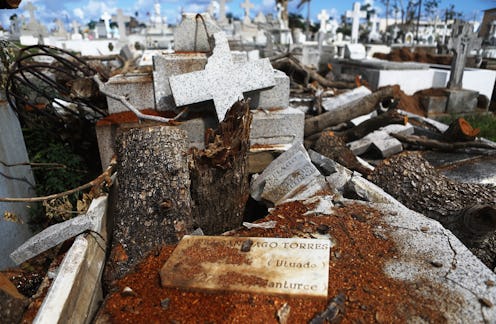News
A New Study Found Hurricane Maria Killed Thousands More Puerto Ricans Than We Thought

More people died in Puerto Rico during Hurricane Maria than died in the United States on September 11th, 2001. That's according to a study published Tuesday in the New England Journal of Medicine, which found that Puerto Rico's death toll during Hurricane Maria was far, far greater than the government's official death toll of 64.
The study was led by scientists at the Harvard T.H. Chan School of Public Health and Beth Israel Deaconess Medical Center, and carried out by researchers in the United States and Puerto Rico. They found in fact, at least 4,645 people — and perhaps as many as 5,740 — died in the U.S. territory during Maria's wrath. If accurate, this would mean that the storm was over 72 times deadlier than government officials on the island claimed at the time.
When asked about the study, the executive director of the Puerto Rico's Federal Affairs Administration acknowledged that officials always suspected the death toll would rise, though he didn't address the size of the discrepancy.
“As the world knows, the magnitude of this tragic disaster caused by Hurricane Maria resulted in many fatalities,” Carlos R. Mercader said in a statement. “We have always expected the number to be higher than what was previously reported.”
The researchers arrived at the number by randomly selecting nearly 3,000 households on the island, which is part of the United States, and comparing the death rates to that of the island the year before. They found that between September 20th, when the storm made landfall on the island, and December 31st, 2017, the death rate in Puerto Rico was 14.3 per 1,000 residents. That's a 62 percent increase from the death rate in 2016, they researchers found, meaning that an additional 4,645 people died during the storm than otherwise would have.
Domingo Marqués, one of the study's authors and an associate professor of psychology at Albizu University San Juan, told NBC News that most people appeared to have died not from the storm's most immediate effects — flying debris or flooded buildings, for instance — but from a lack of access to basic necessities in the aftermath of the hurricane.
"The question is why did it happen? Why did people die? Well, they died mostly because they didn't have access to medical care, they didn't have access to their medication, there was no pharmacy open, they didn’t have running potable, clean water," Marqués said.
The governments of the United States in general and, to a lesser extent, Puerto Rico specifically faced widespread criticism over their handling of the storm, both leading up to it and in its aftermath. When Gov. Ricardo Rosselló's government announced that officially, only 64 people died in the storm, there was immediate pushback. San Juan Mayor Carmen Yulín Cruz claimed that as many as 500 might have died, while the New York Times pegged the death toll at over 1,000 in December.
In October, President Trump said that Hurricane Maria was not "a real catastrophe like [Hurricane] Katrina," explaining that "literally thousands of people" died in Katrina but not in Maria. As it turns out, Trump was factually incorrect on both counts: Thousands of people (literally) did die during Maria on Puerto Rico, according to the new study, while Katrina killed 1,833 people, according to the National Hurricane Center, making Maria more than twice as deadly as Katrina.
In light of the pushback over the official death toll, Rosselló announced in February that an independent task force, headed by researchers at George Washington University, would carry out a study to determine how many people died in Puerto Rico as a result of Maria. In his statement Tuesday, Mercader said that the results of the George Washington study "will be released soon."